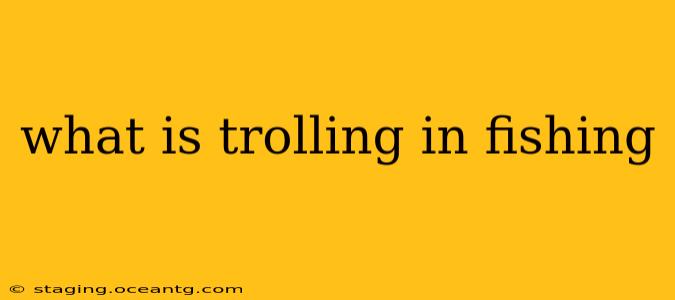Trolling, in fishing, is a technique where you drag one or more fishing lures or baits through the water behind a moving boat. It's a highly effective method for covering vast expanses of water and targeting a wide variety of fish species. Unlike other fishing methods like casting or still fishing, trolling keeps your bait consistently in the strike zone, increasing your chances of a successful catch. This comprehensive guide will explore the nuances of trolling, answering common questions and providing insights to help you master this exciting angling technique.
What are the different types of trolling?
There are several types of trolling, each suited to different fishing situations and target species. These include:
- Downrigger Trolling: This involves using a downrigger to precisely control the depth of your lure, allowing you to target fish at specific depths, particularly effective in deeper lakes or oceans.
- Planer Board Trolling: Planer boards are devices that allow you to spread out your lines away from the boat, increasing the area you cover and allowing you to run multiple lines simultaneously. This is especially useful for targeting schooling fish.
- Flatlining Trolling: This is a simpler form of trolling where the lure is simply trailed behind the boat at the surface or near the surface. It's a great way to target surface feeders.
- Leadcore Trolling: Leadcore line is a type of fishing line with a lead core, which allows you to get your lure down to a specific depth without the need for downriggers.
What kind of equipment do I need for trolling?
Successful trolling requires the right equipment. Key items include:
- A suitable boat: The size and type of boat will depend on the type of trolling you intend to do and the size of the water body.
- A trolling motor: This provides precise speed control, crucial for effective trolling.
- Rods and reels: Sturdy trolling rods and reels designed for the type of lure and fish you're targeting are essential.
- Trolling lures and baits: A variety of lures and baits will increase your chances of success, as different lures attract different fish.
- Line and accessories: Strong fishing line appropriate for the size of the fish you are targeting, as well as other accessories like swivels and snap swivels, are crucial.
- Depth finders and fish finders: These electronic devices help you locate fish and adjust your trolling depth accordingly. This is particularly valuable in downrigger trolling.
What are the best lures for trolling?
The best lure for trolling will vary depending on the species of fish you are targeting and the water conditions. Popular choices include:
- Crankbaits: Effective for targeting a wide range of fish, crankbaits come in various sizes, colors, and diving depths.
- Spoons: These metal lures create an attractive flash and vibration in the water.
- Plugs: These lures mimic the appearance and action of baitfish.
- Live Bait: Live bait, like minnows or herring, can be incredibly effective, particularly when targeting certain predatory fish.
How fast should I troll?
The ideal trolling speed varies greatly depending on the lure, the target species, and water conditions. Experimentation is key to finding the optimal speed. Generally, slower speeds are better for attracting more finicky fish, while faster speeds may attract more aggressive species.
What are some common mistakes to avoid when trolling?
Several common mistakes can significantly reduce your success rate when trolling. These include:
- Using the wrong lures: Choosing lures inappropriate for the target species or water conditions.
- Trolling at the wrong speed: Not adjusting your speed to match the lure and target fish.
- Not using the right equipment: Using substandard equipment that breaks down or fails to perform adequately.
- Ignoring your electronics: Failing to utilize fish finders or depth finders to locate fish.
By understanding the principles of trolling and employing the right techniques and equipment, you'll significantly improve your chances of a successful and enjoyable fishing experience. Remember to always practice responsible fishing and adhere to local regulations.
